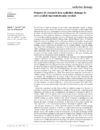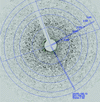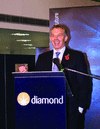issue contents
January 2007 issue
Includes papers presented at the Fourth International Workshop on X-ray Radiation Damage to Biological Crystalline Samples
Harima, Japan, 7-8 March 2006

Cover illustration: The absorbance spectra of a disulfide bond in the absence and presence of a radioprotectant molecule during X-ray exposure (see Southworth-Davies and Garman, pages 73-83). Centre: protein crystal after X-ray irradiation at 100 K and brief annealing at room temperature. Bubbles of gas may contain CO2 originating from the decarboxylation of glutamic and aspartic acid residues (see Fioravanti, Vellieux, Amara, Madern and Weik, pages 84-91).
facility information
radiation damage
Open  access
access
 access
accessOpen  access
access
 access
accessA systematic study of radiation damage has been conducted for various X-ray energies at beamline BL41XU at SPring-8. The dependence of radiation damage on photon energy is discussed.
The X-ray-induced photoreduction of three different crystalline heme proteins was followed on-line by UV-Vis absorption spectroscopy and X-ray crystallography.
Various effects of X-ray exposure observed during diffraction from macromolecular crystals are described. Impact on the quality of diffraction data, experimental phasing procedures and interpretation of biological results are analyzed.
Site-specific radiation-induced phasing through dose-dependent modelling of heavy-atom parameters and the use of unmerged data is discussed.
A comparison of SAD and two-wavelength MAD phasing under similar experimental conditions is made for three different seleno-methionine samples, and the implications for data collection strategy are discussed.
Open  access
access
 access
accessThe lifetime of selenomethionine in a protein crystallography X-ray beam was measured and the effects of varying sample parameters such as temperature, volume, physical state, Se concentration, chemical additives and protein structure were evaluated. Depending on the combination of these parameters, the dose required to damage half of the selenomethionine in a sample varied by as much as a factor of eight.
Open  access
access
 access
accessA range of radioprotectants have been tested as a possible means of reducing radiation damage in protein cryocrystallography, using an online microspectrophotometer.
The radiation susceptibilities of the acidic side-chains are analysed with respect to their chemical and structural environment in crystals of the malate dehydrogenase from Haloarcula marismortui.
A general multi-crystal macromolecular X-ray data collection strategy has been developed for dealing with rapid X-ray-induced redox changes, in which chromophore anisotropy in the crystal does not enable concurrent UV/Vis absorbance measurements during X-ray data collection. The use of this approach is demonstrated for reaction intermediates in the methylamine dehydrogenase oxidative half-reaction.
Open  access
access
 access
accessRaman spectra have been collected from cryocooled DNA crystals in combination with macromolecular cystallography data collection. The specific X-ray-induced breakage of a C—Br bond could be monitored in detail by both techniques.
Thermal imaging is used for the first time to measure the temperature rise of a sample exposed to a third-generation synchrotron X-ray beam.
Modern approaches to limit the damaging effects of electron beam irradiation during diffraction and imaging for high-resolution polypeptide structure determination are reviewed. The important question of whether analogous means can be used to decrease radiation damage to protein crystals during synchrotron X-ray diffraction is critically discussed.
Open  access
access
 access
accessThe technique of freeze-substitution, commonly used in electron microscopy, has been applied to vitrified protein crystals. These plastic-embedded crystals have been examined in terms of X-ray diffraction properties and radiation hardness.
research papers
A comprehensive treatment of the limitations and possibilities for single-pulse selection in synchrotron operating modes with ∼150 ns bunch separation, as occurs in the standard operating mode at the Advanced Photon Source, is presented.
The development of a sagittally focusing double-multilayer monochromator for X-ray radiographic and tomographic applications is described.
A 3 × 6 arrayed charge-coupled device (CCD) X-ray detector has been developed for the continuous-rotation method in macromolecular crystallography at the Photon Factory.
Use of pixel detectors at synchrotron beams.
An introduction to fluorescent X-ray computed tomography imaging with synchrotron radiation to detect fatty acid metabolic abnormalities in cardiomyopathy.
The design of an off-axis magnetron sputtering chamber for in situ X-ray scattering study of superlattices film growth is described. The performance of the chamber is demonstrated by observation of the effects of the modulation length and the stacking period on the growth characteristics of BaTiO3/LaNiO3 artificial superlattices.
Open  access
access
 access
accessDifferential EXAFS (DiffEXAFS) is a novel technique for measuring atomic perturbations on a local scale. Here a complementary technique for such studies is presented: differential X-ray diffraction (DiffXRD), which may be used to independently verify DiffEXAFS results whilst using exactly the same experimental apparatus and measurement technique. A test experiment has been conducted to show that DiffXRD can be used to successfully determine the thermal expansion coefficient of SrF2.
current events
Free 

notes for authors
Free 



 journal menu
journal menu
















































